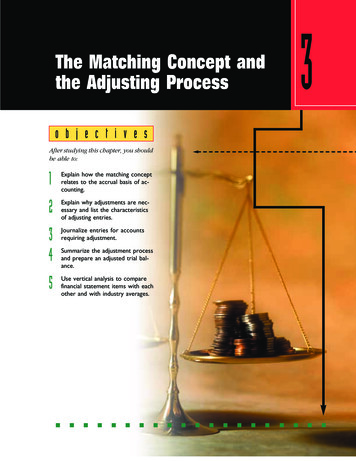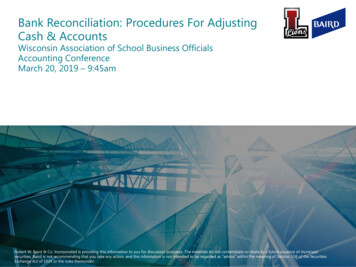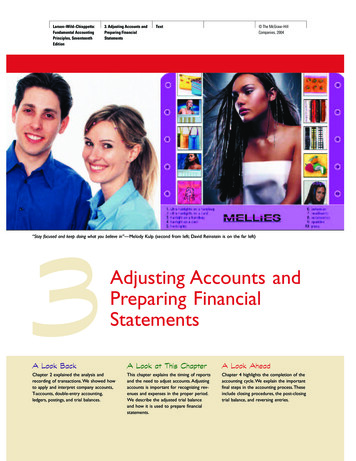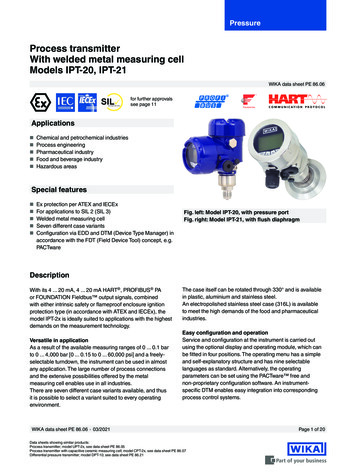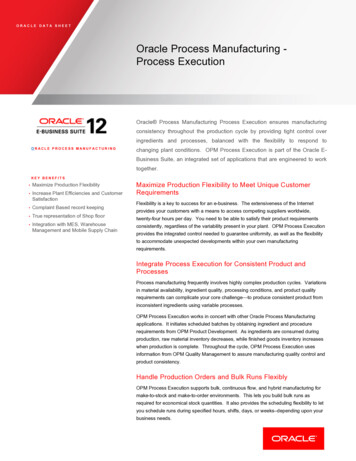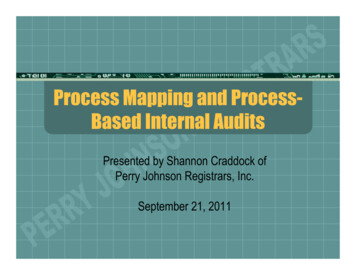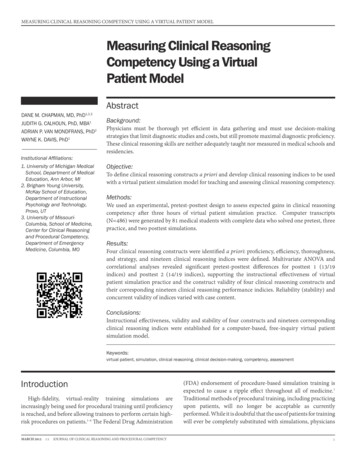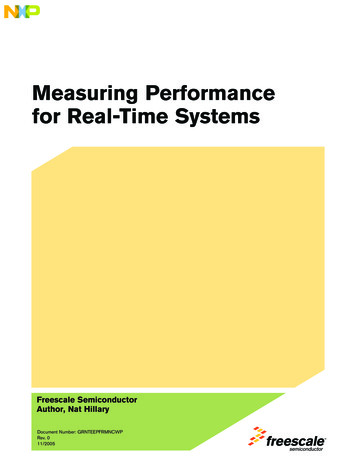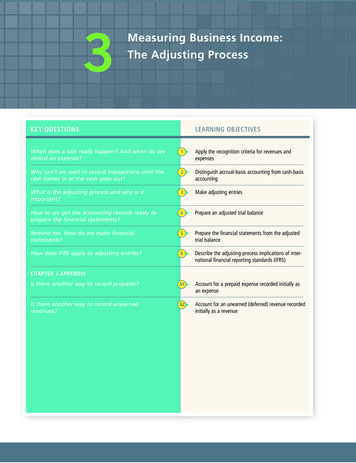
Transcription
3Measuring Business Income:The Adjusting ProcessKEY QUESTIONSLEARNING OBJECTIVESWhen does a sale really happen? And when do werecord an expense?1Apply the recognition criteria for revenues and expensesWhy can’t we wait to record transactions until thecash comes in or the cash goes out?2Distinguish accrual-basis accounting from cash-basisaccountingWhat is the adjusting process and why is it important?3Make adjusting entriesHow to we get the accounting records ready toprepare the financial statements?4Prepare an adjusted trial balanceRemind me. How do we make financial statements?5Prepare the financial statements from the adjustedtrial balanceHow does IFRS apply to adjusting entries?6Describe the adjusting-process implications of international financial reporting standards (IFRS)Is there another way to record prepaids?A1Account for a prepaid expense recorded initially asan expenseIs there another way to record unearnedrevenues?A2Account for an unearned (deferred) revenue recordedinitially as a revenueCHAPTER 3 APPENDIX
Tracy Daytona’s Trim and Detail is a NASCAR-themed hair salon whose primary customerbase is men. Their business model is unique in that it is a salon that does not look likea salon!Customers are invited in for more than just haircuts. They offer haircuts, tanning,shaves, and salon products.How does the owner know if the salon is making money? Can the salon hire anotherstylist? Would the business be able to get a loan to open a new location? This informationto answer these sorts of questions can only come from accurate recordkeeping and thepreparation of the financial statements. To produce complete and accurate financial statements, the business needs to account for all transactions, even those that may not havetypical source documents.Suppose Tracy Daytona’s stylists work today but receive their paycheques next week.If the financial statements need to be prepared before payday next week, wages expenseon the income statement would be too low if several days of wages were not recorded.An adjusting entry would ensure that the wages expense and the wages payable liabilityare included in the accounting records so the income statement and balance sheet arecomplete and accurate.Suppose an order of tanning supplies arrived today without an invoice. If the financialstatements must be prepared tomorrow, the supplies asset and the account payable to thesupplier would be too low if this transaction in not recorded. Again, an adjusting entry willmake the accounting records complete, which will lead to complete and accurate financialstatements. This chapter will look at adjusting entries—why they are done and how theyare done—and the documents accountants use to create the financial statements.121
Connecting Chapter 31Apply the recognition criteria forrevenues and expensesWhen does a sale really happen?And when do we record anexpense?Recognition Criteria for Revenuesand Expenses, page 125234Distinguish accrual basis accounting from cash basisaccountingWhy can’t we wait to recordcash transactions when thecash comes in or the cashgoes out?Make adjusting entriesPrepare and adjusted trial balanceWhat is the adjusting processand why is it important?How do we get the accountingrecords ready to prepare thefinancial statements?Accrual-Basis Accounting versusCash-Basis Accounting, page 126Adjusting the Accounts,page 128The Adjusted Trial Balance,page deo: Cash Basis versusAccrual Basis AccountingVideos: Accrued ExpensesFixed Assets and DepreciationPrepaid ExpensesRoad Map to Adjusting EntriesUnearned RevenueUnearned Revenue AdjustingEntriesAnimation: Accounting Cycle Tutorial (Adjustments)56A1Prepare the financial statementsfrom the adjusted trial balanceDescribe the adjusting-processimplications of internationalfinancial reporting standards(IFRS)How does IFRS apply to adjustingentries?Account for a prepaid expenserecorded initially as an expenseAccount for an unearned (deferred)revenue recorded initially as arevenueIs there another way to recordprepaids?Is there another way to recordunearned revenues?Adjusting-Process Implicationsof International Financial Reporting Standards (IFRS),page 146Alternative Treatment ofAccounting for PrepaidExpenses and Unearned Revenues, page 152Alternative Treatment of Accounting for PrepaidExpenses and UnearnedRevenues, page 152Remind me. How do we preparethe financial statements?Preparing the Financial Statements from the AdjustedTrial Balance, page 143A2Relationships among the ThreeFinancial Statements, page 143MyAccountingLabAnimation: (from Chapter 1)Relationships among the Financial StatementsAnimation: AccountingCycle Tutorial ( FinancialStatements)MyAccountingLab Chapter 3: Accounting Cycle Tutorial Chapter 3: DemoDoc covering The Adjusting Process Chapter 3: Student PowerPoint Slides Chapter 3: Audio Chapter SummaryAll MyAccountingLab resources can be found in the Chapter Resources section and the Multimedia Library.The Summary for Chapter 3 appears on page 151.Accounting Vocabulary with definitions appears on page 155–156.122Part 1 The Basic Structure of Accounting
Whetherthe business is Tracy Daytona’s or Hunter EnvironmentalConsulting, the desire to make profits increases the owners’ drive to carry on thebusiness. As you study this chapter, consider how important net income is to abusiness. Getting a true picture of net income will be the focus of this chapter.At the end of each accounting period, the entity prepares its financial statements. The period may be one month, three months, six months, or a full year.Tracy Daytona’s is typical. The company reports internally on a monthly basis.It reports at the end of its year to its banker and other external users, providingAccounting Cycleaudited financial statements.Whatever the length of the period, the end accounting product is theset of financial statements. And one of the most important single amounts1. Identify and analyzeChapter 1in these statements is the net income or net loss for the period. Nettransactionsincome or net loss captures much information: total revenues minus total2. Record transactions inexpenses for the period. A business that consistently earns net incomeChapter 2a journaladds value to its owners, its employees, its customers, and society.An important step in financial statement preparation is the trial bal3. Post (copy) from theance. The trial balance, introduced in Chapter 2 on page 84, lists thejournal to the accounts Chapter 2in the ledgerledger accounts and their balances. The account balances in the trialbalance include the effects of the transactions that occurred during4. Prepare the trial balance Chapter 2the period—cash collections, purchases of assets, payments of bills,sales of assets, and so on. To measure its income, however, a business5. Journalize and postmust do some additional accounting at the end of the period to bringChapter 3adjusting entriesthe records up to date before preparing the financial statements. Thisprocess is called adjusting the books and it consists of making special6. Prepare the financialChapter 3statementsentries called adjusting entries. This chapter focuses on these adjustingentries to show how to measure business income. This is Step 5 of the7. Journalize and post theaccounting cycle shown in the margin.Chapter 4closing entriesThe accounting profession has concepts, assumptions, and principlesto guide the measurement of business income. Chief among these are8. Prepare the postclosing the time period assumption, the recognition principle for revenues and expenses (including thematching of costs with revenues), and the accrual-basis accounting versus cash-basis accounting methods.trial balanceChapter 4In this chapter, we apply these (and other) concepts and principles to measure theincome and prepare the financial statements of Hunter Environmental Consulting(HEC) for the month of April. All other companies follow the same principles.Time-Period AssumptionManagers, investors, and creditors make decisions daily and need periodic readings on the business’s progress. The time-period assumption ensures that accounting information is reported at regular intervals.The most basic accounting period is one year, and virtually all businesses prepare annual financial statements. For many companies, the annual accountingperiod is the calendar year from January 1 through December 31. Other companies use a fiscal year ending on some date other than December 31. A fiscal yearend date is usually chosen to be at the low point in business activity for the year.Retailers are a notable example. Traditionally, their fiscal year ends on or aroundJanuary 31, because the low point in their business activity has followed the afterChristmas sales in January; for Sears Canada Inc., which operates stores acrossCanada, its fiscal year ends on the last Saturday of January.Managers and investors cannot wait until the end of the year to analyze acompany’s progress. Companies, therefore, prepare financial statements forinterim periods, which are less than a year. A series of monthly statements can becombined into quarterly (three month) and semiannual (six month) periods forChapter 3 Measuring Business Income: The Adjusting Process123
investors. Given the fast pace of business, managers want financial informationmore often, so monthly or even daily financial statements provide informationfor decision making. Most of the discussions in this book are based on an annualaccounting period, but the procedures and statements can be applied to interimperiods as well.The remainder of the chapter discusses how to make the adjusting entries tobring the accounts up to date.Recognition Criteria for Revenuesand ExpensesLO 1Recognition is the process of including an item in the financial statements of abusiness. There are two parts to consider. First, we will discuss the recognition ofrevenue; then, we will discuss the recognition of expenses.When does a sale reallyhappen? And when do werecord an expense?Revenue RecognitionThe recognition criteria for revenues tell accountants When to record revenue—that is, when to make a journal entry for a revenuetransaction. The amount of revenue to record.Revenue, defined in Chapter 1, page 17, is the increase in owner’s equity fromdelivering goods and services to customers in the course of operating a business.When we speak of “recording” something in accounting, we mean to make anentry in the journal. That is where the accounting process starts.When to Record Revenue Revenue-recognition criteria state that revenue shouldbe recorded when it has been earned—but not before. In most cases, revenue isearned when the business has delivered a completed good or service to the customer. The business has done everything required by the agreement, includingtransferring the item to the customer.Exhibit 3–1 shows two situations that provide guidance on when to record revenue. The first situation illustrates when not to record revenue, because the clientmerely states her plans. Situation 2 illustrates when revenue should be recorded—after HEC has performed the service for the client.Exhibit3–1Recording Revenue: The Recognition Criteria for RevenuesNo transaction has occurred.The client has used the servicesprovided by HEC.Situation 1—Do Not Record RevenueSituation 2—Record RevenueI plan to haveyou do anenvironmentalassessment ofmy project.124Part 1 The Basic Structure of Accounting
The Amount of Revenue to Record The general principle is to record revenueequal to the cash value of the goods or the service transferred to the customer.Suppose that, in order to obtain a new client, HEC performs environmentalassessment services for the price of 5,000. Ordinarily, the business wouldhave charged 7,000 for this service. How much revenue should the businessrecord? The answer is 5,000 because that was the cash value of the transaction.The business will receive only 5,000 cash, and that pinpoints the amount ofrevenue earned.Recognition Criteria for ExpensesJust as we have criteria that help us determine when to recognize revenue and howmuch revenue we should record, we also have criteria to help us determine whento recognize expenses. This is commonly referred to as the matching objective.Recall that expenses such as utilities and advertising are the costs of assets andservices that are consumed when earning revenue. The matching objective directsaccountants to1. Identify all expenses incurred during the accounting period.2. Measure the expenses.3. Match the expenses against the revenues earned during that period.To match expenses against revenues means to subtract the related expensesfrom the revenues to compute net income or net loss. Exhibit 3–2 illustrates thematching objective.Exhibit3–2Expense Recognition—An Illustration of the Matching ObjectiveTo match expenses against revenues means to subtract the related expenses from the revenuesin order to compute net income or net loss. 800 600 600 500The result: 200RevenueExpenseNET INCOME SITUATIONNet IncomeRevenueExpenseThe result:– 100(Net Loss)NET LOSS SITUATIONAccountants follow the matching objective by first identifying the revenuesof a period and then the expenses that can be linked to particular revenues. Forexample, a business that pays sales commissions to its salespeople will have commission expense if the employees make sales. If they make no sales, the businesshas no commission expense.Other expenses are not so easy to link with particular sales. HEC’s monthly rentexpense occurs, for example, regardless of the revenues earned during the period.The matching objective directs accountants to identify these types of expenseswith a particular time period, such as a month or a year. If HEC employs an officeassistant at a monthly salary of 2,500, the business will record salary expense of 2,500 each month.Chapter 3 Measuring Business Income: The Adjusting Process125
How does HEC bring its accounts up to date for preparing the financial statements? We will address this question in the next section. JUST CHECKINGMyAccountingLab1. Why is it important to have recognition criteria for both revenues and expenses?2. On December 20, 2013, Kobe Company receives an order from Windsor Companyfor products costing 5,000. The order will not be shipped until January 5, 2014.Kobe Company wants to record the revenue on December 20 so it can include itin the current year’s financial statements. As Kobe’s accountant, you object to thisaccounting treatment. Why?3. On December 20, 2013, Kobe Company receives an order from Windsor Companyfor products costing 5,000. The order is shipped immediately. Kobe Companypays a commission of 5 percent of the selling price to its sales representative whoreceived the order. This commission will not be paid until January 2014. Kobe’sfiscal year end is December 31. What is the journal entry needed to account for thesales commission?Just Checking Solutions appear at the end of this chapter and on MyAccountingLab.Accrual-Basis Accounting versusCash-Basis AccountingLO 2Why can’t we wait to recordtransactions until the cashcomes in or the cash goes out?MyAccountingLabVideo: Cash Basis versus Accrual BasisNow that you have seen the more correct way to record entries, it needs to beacknowledged that there are really two ways to do accounting: Accrual-basis accounting, frequently called accrual accounting, records the effect of every business transaction as it occurs, no matter when cash receiptsand cash payments occur. Accrual accounting is based on the time period assumption and recognition criteria for revenues and expenses. For this reason,most businesses use the accrual basis because it is required by GAAP (whichincludes both accounting standards for private enterprises [ASPE] and international financial reporting standards [IFRS]). Thus, accrual-basis accounting isthe method covered in this book. The Canada Revenue Agency (CRA) requiresaccrual accounting for income tax purposes except in special cases. Cash-basis accounting records transactions only when cash receipts and cashpayments occur. It ignores receivables, payables, and other expenses covered later in this chapter. Only very small businesses tend to use cash-basis accounting.Exhibit 3–3 illustrates the difference between the accrual basis and the cash basisof accounting for a real estate agent. For an expense transaction, notice that theaccrual basis records the payable and the expense when the advertisement is putin the newspaper, whereas the cash basis records the expense only when it is paid.For a revenue transaction, notice that the accrual basis records a receivable and arevenue when the agent earns the commission by completing the sale, whereas thecash basis records the revenue only when the cash is received 30 days later.As we saw in Exhibit 1–6 on page 13 and on the inside back cover of this book,the objective of financial statements is to communicate information that is usefulto users. Accrual-basis accounting provides more complete information than doescash-basis accounting. This difference is important because the more complete thedata, the better equipped decision makers are to reach accurate conclusions aboutthe firm’s financial health and future prospects. Three concepts used in accrualaccounting are the accounting period, the recognition principle, and the timeperiod assumption.126Part 1 The Basic Structure of Accounting
Exhibit3–3Accrual-Basis Accounting versus Cash-Basis AccountingAccrual BasisCash BasisExpense Example: Suppose Ali Chow, a real estate agent, purchased 2,000 of newspaper advertising on accounton January 14 and will pay the newspaper in 30 days (on February 13).Jan 14Advertising ExpenseAccounts PayablePurchased advertising on account.Jan 14 No journal entry because no cash was paid.2,0002,000Feb 13 Accounts Payable2,000CashPaid for advertising purchased on account.2,000The accrual basis records the advertising expense when the realestate agent places the advertisement on January 14. The accrualbasis also records the Accounts Payable liability on January 14since the agent owes money to the newspaper on that date.Ali ChowBalance SheetJanuary 14, 2014Cash 15,000Accts receivable-Ali ChowIncome StatementFor the Period Ended January 14, 2014Accountspayable 2,000Revenue 11,000ExpensesA. Chow,Capital 13,000Total liabTotal assets 15,000 & equity 15,000Advertising2,000Phone150Rent300Total expenses 2,450 8,550Net incomeFeb 13 Advertising ExpenseCashPurchased advertising on January 14.2,0002,000The cash-basis accounting records are not accurate and completeon January 14 because they do not show the expense or the liability at that date.Ali ChowBalance SheetJanuary 14, 2014Ali ChowIncome StatementFor the Period Ended January 14, 2014AccountsCash 15,000 payable Accts receivableA. Chow,Capital 15,000Total liabTotal assets 15,000 & equity 15,000Revenue 11,000ExpensesAdvertising Phone150Rent300Total expenses 450Net Income 10,550Revenue Example: Suppose Ali Chow sold the house that wasadvertised and earned commission in the amount of 15,000when the deal closed on March 8. She will collect no cash untilApril 7.March 8 Accounts ReceivableCommission RevenueEarned revenue on account.Mar 8 No journal entry because no cash was received.15,00015,000April 7Cash15,000Accounts Receivable15,000Cash received on account.The accrual basis records the revenue when Ali earns the revenueby selling the house in March. The accrual basis also records theAccounts Receivable as an asset on March 8 since Ali is owed thisamount for the service performed.Ali ChowBalance SheetMarch 8, 2014Cash 17,000Acctsreceivable 15,000Ali ChowIncome StatementFor the Period EndedMarch 8, 2014Accountspayable - RevenueA. Chow,CapitalTotal liabTotal assets 32,000 & equity 26,000April 7 CashCommission RevenueEarn
What is the adjusting process and why is it important? How do we get the accounting records ready to prepare the financial statements? Recognition Criteria for Revenues and Expenses, page 125 Accrual-Basis Accounting versus Cash-Basis Accounting, page 126 Adjusting the Accounts, page
